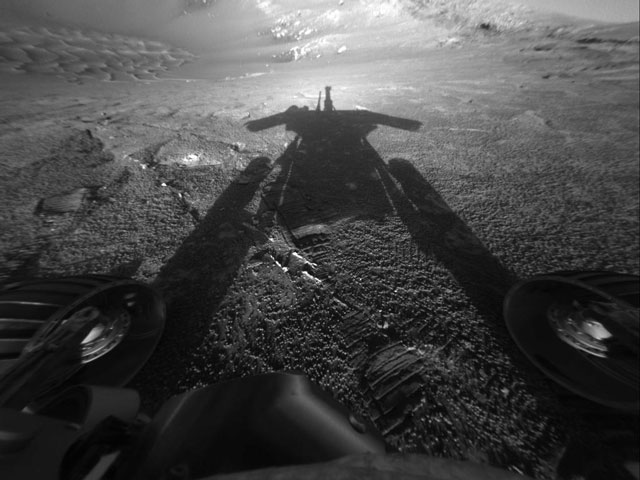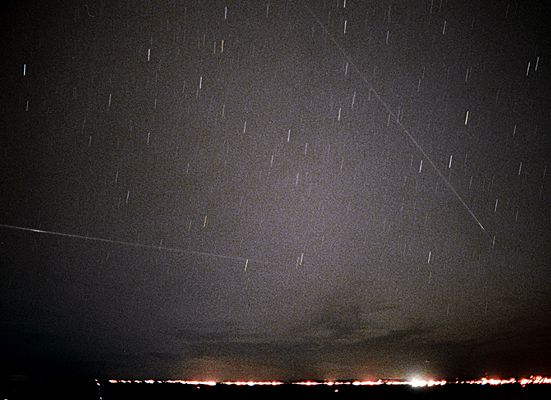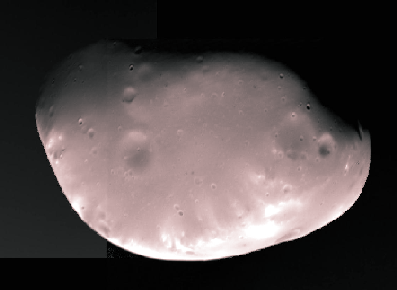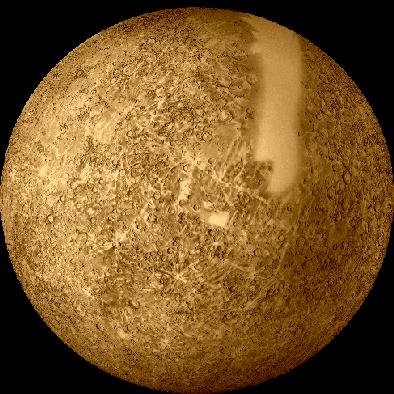
Add to Favorites
What if you saw your shadow on Mars and it wasn't human? Then you might be the Opportunity rover currently exploring Mars. Opportunity and sister robot Spirit have been probing the red planet since January, finding evidence of ancient water, and sending breathtaking images across the inner Solar System. Pictured above, Opportunity looks opposite the Sun into Endurance Crater and sees its own shadow. Two wheels are visible on the lower left and right, while the floor and walls of the unusual crater are visible in the background. Opportunity is cautiously edging its way into this enigmatic crater, hoping to find new clues into the wet ancient past of our Solar System's second most habitable planet.
2004-08-03 no copyright
Add to Favorites
What color is the universe? More precisely, if the entire sky were smeared out, what color would the final mix be? This whimsical question came up when trying to determine what stars are commonplace in nearby galaxies. The answer, depicted above, is a conditionally perceived shade of beige. In computer parlance: #FFF8E7. To determine this, astronomers computationally averaged the light emitted by one of the larger samples of galaxies analyzed: the 200,000 galaxies of the 2dF survey. The resulting cosmic spectrum has some emission in all parts of the electromagnetic spectrum, but a single perceived composite color. This color has become much less blue over the past 10 billion years, indicating that redder stars are becoming more prevalent. In a contest to better name the color, notable entries included skyvory, univeige, and the winner: cosmic latte. Gallery: Notable images of the Great Conjunction submitted to APOD
2020-12-27 no copyright
Add to Favorites
Streaking low across the western horizon after sunset, the Russian Mir space station makes a final pass through the evening sky above the coastal city of Salvador, Brazil. In this 5 minute 20 second time exposure made with ASA 800 film and a wide-angle lens on March 19, setting stars leave short, almost vertical trails. A rapidly moving Mir travels horizontally, trailing toward the left (south) edge of the picture. Reflecting sunlight from low Earth orbit, the historic space station chanced to produce a "farewell" flare near the end of its visible track. As if in poignant response, the Hubble Space Telescope appeared in Brazilian skies within a minute after Mir's passage and also left a flare along a trail moving toward the top of the picture. Lights visible on the horizon are from nearby Itaparica Island. After 15 years in service, the long-lived Mir space station was safely deorbited today. The splashdown of its surviving pieces occurred in a remote area of the South Pacific Ocean.
2001-03-23 Paulo Raymundo (Salvador, Brazil)
Add to Favorites
Mars has two tiny moons, Phobos and Deimos. Pictured above is Deimos, the smallest moon of Mars. In fact, Deimos is the smallest known moon in the Solar System measuring only 9 miles across. The diminutive Martian moons were discovered in 1877 by Asaph Hall, an American astronomer working at the US Naval Observatory in Washington D.C. The existence of two Martian moons was predicted around 1610 by Johannes Kepler, the astronomer who derived the laws of planetary motion. In this case, Kepler's prediction was not based on scientific principles, but his writings and ideas were so influential that the two Martian moons are discussed in works of fiction such as Jonathan Swift's "Gulliver's Travels", written in 1726, over 150 years before their actual discovery.
1995-10-03 no copyright
Add to Favorites
Mercury, the closest planet to the Sun, remains the most mysterious of the Solar System's inner planets. Hiding in the Sun's glare it is a difficult target for Earth bound observers. The only spacecraft to explore Mercury close-up was Mariner 10 which executed 3 flybys of Mercury in 1974 and 1975, surveying approximately 45 percent of its surface. Mariner 10 deftly manuevered to photograph part of the sunlit hemisphere during each approach, passed behind the planet, and continued to image the sun-facing side as the spacecraft receded. Its highest resolution photographs recorded features approximately a mile across. A recent reprocessing of the Mariner 10 data has resulted in this dramatic mosaic. Like the Earth's Moon, Mercury's surface shows the scars of impact cratering - the smooth vertical band and patches visible above represent regions where no image information is available.
1998-09-06 no copyright